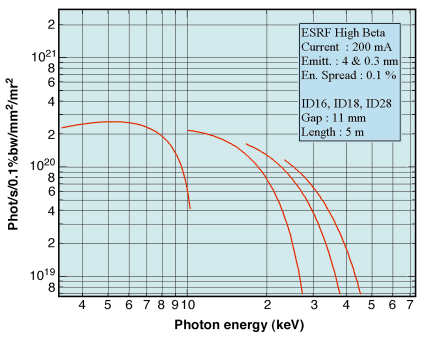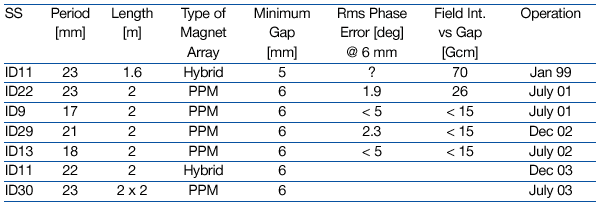Undulators
Following the recent installation of several 10 mm-thick ID chambers on ID16, ID18 and ID28, the undulator segments of these beamlines were changed to a shorter magnetic period. These three beamlines now operate the equivalent of a 5 m-long undulator with a minimum gap of 11 mm. Figure 133 gives the brilliance reached in multibunch mode (uniform and 2 x 1/3 filling mode). A complete list of the installed insertion device segments is presented at the following address:
http://www.esrf.fr/Accelerators/Groups/InsertionDevices/Engineering/Ids/Installed_IDs
 |
|
Fig. 133: Brilliance reached on ID16, ID18 and ID28 with three segments operated at a minimum gap of 11 mm. |
Two additional in-vacuum undulators were installed in 2002. The status of the in-vacuum undulators is given in Table 6.
 |
|
Table 6: Status of in-vacuum undulators. |
Five beamlines operate with the combination of one in-vacuum undulator segment and one conventional open-air undulator. The short period U17 and U18 installed on ID9 and ID13 are intended to operate on either the fundamental or third harmonic, and consequently no particular attention was given to precise phase shimming. Whereas for ID22 and ID29, which are intended to be used at high energy, have been phase shimmed to around 2 deg rms. During the initial tests made on U17, beam loss occurred for gaps below 6.5 mm. Possible damage to the nickel copper sheet placed on the upper magnet assembly was immediately suspected and was confirmed during the May machine shutdown. Investigation showed that the sheet had been damaged by both the electron beam as well as by synchrotron radiation from the upstream dipole. As a consequence, the thickness of the nickel was increased from 25 to 50 micrometres and an improved fixation was designed. Since then the U17 has been operated at a gap of 6 mm without any further problems.
The removal of the SOLEIL super-conducting cavity, installed on the ID23 straight section, was carried out during the December 2002 shutdown. Three short dipoles made of permanent magnets have been installed in order to generate two undulator beams emitting at ± 750 µrad from the direction of the straight section. The first of these canted undulators (U35) is in place, the other undulator (U20.2), optimised to produce 14 keV X-rays, is being designed.



